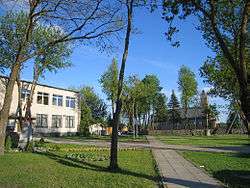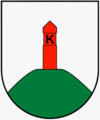Kapčiamiestis
| Kapčiamiestis | ||
|---|---|---|
| Town | ||
|
Central square | ||
| ||
 Kapčiamiestis Location of Kapčiamiestis | ||
| Coordinates: 54°0′0″N 23°39′30″E / 54.00000°N 23.65833°ECoordinates: 54°0′0″N 23°39′30″E / 54.00000°N 23.65833°E | ||
| Country |
| |
| Ethnographic region | Dzūkija | |
| County |
| |
| Municipality | Lazdijai district municipality | |
| Eldership | Kapčiamiestis eldership | |
| Capital of | Kapčiamiestis eldership | |
| First mentioned | 16th century | |
| Population (2001) | ||
| • Total | 727 | |
| Time zone | EET (UTC+2) | |
| • Summer (DST) | EEST (UTC+3) | |

Kapčiamiestis (Polish: Kopciowo) is a town in Lithuania located near the confluence of Baltoji Ančia and Nieda Rivers.
History
Town traces its history dating back in early 16th century, then a manor was built. In 1777 a parish-school was opened here.
In the town's cemetery, Polish national hero, Emilia Plater, was buried in 1831. The town had an important Jewish community. When the Germans entered the town on 22 June 1941, Lithuanian nationalism broke loose. On 15 September 1941, all of the Jews were taken under high security to Lazdijai. There they were put into a ghetto established in Katkishes, one kilometer outside of Lazdijai, where Jews from neighboring villages were interned. On 3 November 1941 the Jews of Kapčiamiestis were murdered with the rest of the ghetto inhabitants.[1] Kapčiamiestis was devastated by World War II, after which most of the historical buildings were destroyed.
Références
| Wikimedia Commons has media related to Kapčiamiestis. |


